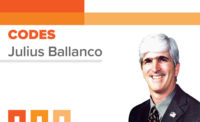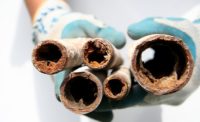For those familiar with Appendix L of the UPC 2015 code, the section that addresses hard water in the 2018 update will be instantly recognizable, albeit renumbered L.505 from L.605.
L 505.1 Softening and Treatment: Where water has a hardness equal to or exceeding 10 grains/gal., measured as total calcium carbonate equivalents, the water supply line to water-heating equipment and the circuit of boilers shall be softened or treated to prevent accumulation of limescale and consequent reduction in energy efficiency.
The code only highlights the loss of energy efficiency caused by limescale encrustation. Scale is 400 times less conductive of heat than copper so just 1/8 of an inch of limescale can cause a 12% loss in heating efficiency. That extra efficiency you are specifying with condensing boilers can be lost in a few months if the water is hard.
In practice, the energy-loss issue applies only to gas water heaters and other heat exchangers. There currently is no evidence that scale increases the energy consumption of electric heaters, it just causes them to increase their recovery time and fail prematurely.
There are plenty of other reasons to treat hard water, not the least to extend the life of equipment, to improve hygiene and to reduce the risk of Legionella in piping systems. Legionella loves to live in scale. Another cause of energy loss is the need for pumps to work harder to overcome the restriction in flow rate caused by scaled-up plumbing and valves such as backflow preventers.
If you pick up the phone to call the softener guy just know the issues that could arise. A water softener can be expensive to install, may take up a lot of space and there has to be access for the salt delivery and storage.
Incidentally, installing a softener in the same plant room as a gas water heater can be an issue. Sucking up salt-laden air can significantly damage a gas heater quicker than most other things. You will have to explain all this to the client and justify the cost. The client also may point out that the initial install cost of a softener is the least-expensive item in its relatively short, but maintenance-intensive life.
IAPMO approved
If you mention the possibility of an alternative “no-salt softener” to your water-treatment professional you likely will be told that these units don’t work, are a waste of money and none are tested or proven.
That last statement is no longer true. IAPMO recently published IGC 335-2018 Rapid Scaling Test which now is the only national performance standard for scale-reducing devices. An electronic, radio-wave-emitting physical water conditioner was tested by IAPMO R&T laboratories, according to the IGC 335 protocol.
The result showed a reduction of scale of 83% when tested on Las Vegas water heated to 180o F. The high temperature of the test water is significant because the rate of scale formation is much greater at this higher temperature than it is at the lower normal water temperature of water heaters. Actual results on the lower temperature will be significantly better than 83%. Also significant is the source and hardness of the region’s water, Lake Mead on the Colorado River, which provides the life blood for around 40 million people in the Southwest at a hardness in excess of 18 gr/gal.
Scale will nucleate onto something when water is either heated or the water pressure drops. Dissolved calcium bicarbonate in the water converts into solid calcium carbonate, leaving carbon dioxide and water as the other by-products. Importantly, scale only sticks to things when it is forming. The no-salt softener tested uses radio waves to modify the iron (Fe) molecules in water in such a way that it will attract scale to nucleate on them in suspension in the water instead of encrusting the surfaces where it would otherwise form. The water now contains fine scale particles, like chalk dust, which are carried away with the flow of the water.
The radio waves are transmitted into the water using two antenna wrapped around the exterior of the water-supply pipe. The signal travels both upstream and downstream in the water so where there is continuity in the water supply, heaters upstream of the device can be just as easily treated as those downstream. Pumps and break tanks interfere with the signals so the correct location on a complex plumbing system is vitally important and multiple units may be required in large buildings.
These units are inexpensive, simple to install and require no extra space. They also are completely maintenance-free and are warranted for 20 years with a design life in excess of 40 years, so a client should have no concern about paying the small extra cost knowing it will save money in the short and long term. It also won’t need constant service and replacement.
Iron testing
So how does an engineer find out if there is iron in the water? This is really the subject for a whole new article, but briefly, if you live in Lubbock, Texas, or some areas north of Oklahoma City, Oklahoma, you may find natural water that is iron free. Many water-quality reports may show iron as “ND,” not detected, but this does not necessarily mean the water is free of iron. Often the testing for iron only goes down to 50 parts per billion and it is only when the level drops below 10 ppb that effectiveness falls off. Our experience across the country from North Slope, Alaska, to Miami, Florida, has shown there is enough iron to make this technology work, even if the local water-quality report marks iron as ND.
If, however, the supply is by artificial water from municipal reverse-osmosis systems such as the Orange County Ground Water Replenishment Scheme in the lower Santa Ana Valley (California) or the Chino De-salter Authority in the Inland Empire of California, to give two examples, you are unlikely to have much, if any iron in the water.
This technology is not new, it has been the industry standard in the United Kingdom for 20 years. What is new is having a performance standard that provides backup.
This means the question the engineer should be asking no longer is, “Should I specify a water softener with all the cost and complications it entails?”
Instead, the question now should be, “Can I think of any reason not to install this proven technology?”





